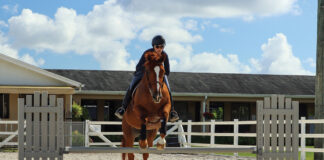Q: When I jump my horse he always takes off way too early, to the point that I’m scared of crashing or falling off. It helps to set placement poles in front of the jumps but as soon as I take them away he starts leaving from really long spots again. How can I get him to consistently canter to a safe take-off spot?
First, go back to using your placement poles, but set them for trotting exercises. Lay one ground pole about 9 feet in front of your practice jump and lay another one the same distance away on the landing side. Spend plenty of time trotting back and forth over low, simple jumps with these placement poles. Your horse is not ready to canter jumps until he remains relaxed, quiet and on a steady rhythm while trotting them.
Second, canter over poles on the ground. This is often a good diagnostic tool that can reveal how your horse views the whole process of cantering a course of jumps. Just lay the poles intermittently across your track in the arena and incorporate them into your flatwork at the canter. Use your aids to keep your horse collected and on a consistent length of stride as you canter over the poles. If he gets strong or tries to leap over a pole from a long distance, pull him up. If he won’t stop, or ignores your aids, that’s a good indication that he’s leaving from long take-off spots because he lacks some important flatwork fundamentals. Until he responds to your aids and is adjustable on the flat, he’s not ready to canter over jumps.
For your third exercise, set up a basic grid of jumps. Start with one placement pole, set about 9 feet in front of a low (2-foot) vertical. Then measure off 58-59 feet and set another simple vertical (about 2’3”). At an energetic yet controlled working trot, trot over the placement pole, jump the first vertical, and then canter out over the second vertical in five even, steady strides. As a helpful tip, when your horse’s front feet hit the ground after the first vertical, count aloud, “Land, one, two, three, four, five.” He should leave the ground on the count of “five.”
By using structured schooling exercises conducted over low jumps at slow, controlled gaits, your horse should become more adjustable. Over time he’ll learn that it’s okay to leave the ground from deeper, more conservative take-off spots. If you continue to have trouble, consult with a local instructor who can coach you from the ground. Without realizing it, you may be riding your horse to long take-off spots, and until your riding faults are addressed your horse will continue to take those long leaps.
— Cindy Hale
Ask your questions on the HorseChannel.com Forums >>
See more Expert Q&As >>
Submit your Ask the Expert question >>






great tips Cindy!
Sounds great.
Hope I can remember these great ideas come warmer weather.